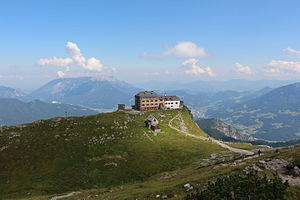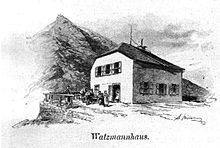Watzmannhaus
| Watzmannhaus DAV hut category I |
||
|---|---|---|
|
Watzmannhaus: photographed on the ascent to the Mittelspitze |
||
| location | Rebate head; Bavaria , Germany ; Valley location: Ramsau near Berchtesgaden | |
| Mountain range | Berchtesgaden Alps | |
| Geographical location: | 47 ° 34 '16 " N , 12 ° 56' 2" E | |
| Altitude | 1930 m above sea level NHN | |
|
|
||
| owner | Munich Section of the DAV | |
| Construction type | hut | |
| Usual opening times | Mid May to mid October | |
| accommodation | 60 beds, 130 camps | |
| Winter room | 10 bearings | |
| Web link | Site of the hut | |
| Hut directory | ÖAV DAV | |
The Watzmannhaus is a Alpenvereinshutte the Munich section of the German Alpine Club in 1930 meters altitude on the north Falzköpfl below the Watzmann -Hocheck. It is located in the Berchtesgaden Alps in the Berchtesgaden National Park in the town of Ramsau near Berchtesgaden . The Watzmannhaus is the most important base on the Watzmann for day and overnight guests. It is managed in summer, a winter room is available in winter .
history
Originally, the Berchtesgaden Alpine Club section planned to build a hut on the Watzmann after laying out several paths. However, the finances were not enough and so the Munich Section, which still belongs to it today, built the Watzmannhaus on the Falzköpfl under the leadership of Franz von Schilcher . The foundation stone was laid on July 2, 1887, and the shell was completed in autumn. After the interior was completed in July of the following year, the Watzmannhaus was inaugurated on August 5, 1888 and offered space for 25 people. The construction work was carried out by the builder Valentin Raspamonti from Tarcento . It is safe from falling rocks and avalanches, but because of its free location it is heavily exposed to the weather.
The large crowd was evident from the start and so the building was expanded for the first time in 1894. The name Münchner Haus am Watzmann , which was introduced at this time , did not establish itself permanently. A larger new building followed from 1908 to 1911 (expanded to 132 beds). He gave the hut its current appearance, with up to 8000 overnight stays annually it is one of the most visited mountain huts of the Alpine Club. In 1987 the water supply was repaired, in 1988 the roof was renovated and re-covered with larch shingles. One problem is the scarcity of water , which caused almost chaotic conditions in the record summer of 2003 . To improve the situation, the house was brought up to date in 2006 with the latest environmental technology. Now there are drinking water tanks and an environmentally friendly energy supply and waste water disposal.
The hut was previously supplied on foot and with pack animals ( mules ), and a material ropeway has been available since 1960 . It overcomes a height difference of 600 meters with a support , the valley station below the Mitterkaseralm can be reached via a forest path by off-road vehicle.
Johann Grill (Kederbacher) was the first hut keeper at the Watzmannhaus until 1905, then his son Johann Grill the Younger took over until 1911. Adolf Adam was the hut keeper in 1911/12, then Anna Gschoßmann with the Högerle family until 1925. From 1925, the Strobl-Bitterling family managed the house for three generations (Emma Sprick-Strobl until 1955, G. and Albert Bitterling until 1977, R. Bitterling until 1984) for a total of 60 years. From 1985 onwards, the Eder, Kaltenbacher, Kurz and Verst families took over.
A general renovation of the house has been taking place since September 2018. The planned demolition and new construction of the Salettl was provisionally prohibited by the Munich Administrative Court following a lawsuit by the Bund Naturschutz .
Accesses
- From the Wimbachbrücke car park (630 m) near Ramsau near Berchtesgaden via the Stubenalm and Mitterkaseralm, easy, walking time: 4 hours
- From Gasthaus Hammerstiel (780 m) near Schönau am Königssee via Schappbachtal and Mitterkaseralm, easy, walking time: 4 hours
- From the village of Königssee (605 m) via the Klingeralm, Kührointalm and Falzalm , medium, walking time: 4½ hours
- From Sankt Bartholomä (605 m) via Rinnkendlsteig, Kührointhütte and Falzalm, the first part is a demanding mountain climb, walking time: 5 hours
Transitions
- Kührointhütte (1420 m) via Falzalm and Höhenweg, medium, walking time: 2 hours
- Wimbachgrieshütte (1330 m) via Watzmann-Hocheck, Mittelspitze, Südspitze and Schönfeldgraben (“Watzmann overrun”), difficulty level I-II according to UIAA , partially secured, high alpine ridge crossing only for experienced mountaineers, walking time: 8–9 hours
Mountaineering
- Watzmann -Hocheck (2651 m) over the north flank, medium, partially secured, walking time: 2½ hours
- Watzmann-Mittelspitze (2713 m) via Hocheck, difficulty level I according to UIAA, partly secured, walking time: 3½ hours
- Watzmann-Südspitze (2712 m) via Mittelspitze, difficulty level I-II according to UIAA, partly secured, walking time: 5 hours
- Small Watzmann (2307 m) and watzmann children are primarily from the Kührointhütte to reach from
literature
- Herbert Kaspar Brandner: History of the Watzmannhaus 1888 - 1988 Alpine Club Section Munich. Memorandum for the centenary. Engedey, Munich Berchtesgaden 1988. Digitized version (PDF, 12 MB)
- Bernhard Kühnhauser: Alpine Club Guide Berchtesgaden Alps with Hochkönig . 20th edition. Bergverlag Rother , Munich 2011, ISBN 978-3-7633-1127-9 , pp. 65 .
Web links
- Website of the Watzmannhaus
- Watzmannhaus in the historical Alpine archive of the Alpine clubs in Germany, Austria and South Tyrol (temporarily offline)
Individual evidence
- ↑ General renovation of the Watzmannhaus. Retrieved June 12, 2020 .
- ↑ Court stops expansion at Watzmannhaus , sueddeutsche.de, June 9, 2020, accessed on July 11, 2020.


